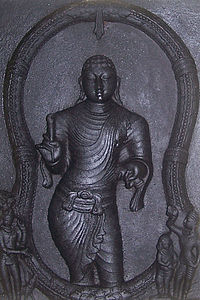Sangam period
This article should specify the language of its non-English content, using {{lang}}, {{transliteration}} for transliterated languages, and {{IPA}} for phonetic transcriptions, with an appropriate ISO 639 code. Bharatpedia's multilingual support templates may also be used. (August 2021) |
This article needs additional citations for verification. (June 2022) |
 Tamilakam, located in the tip of South India during the Sangam Period, ruled by Chera dynasty, Chola dynasty and the Pandyan dynasty | |
| Alternative names | Sangam Age, Third Sangam period, Last Sangam period |
|---|---|
| Geographical range | Indian subcontinent |
| Period | Iron Age India |
| Dates | c. 600 BCE – c. 300 CE |
| Major sites | Keezhadi excavation site, Kodumanal, Arikamedu, Murugan Temple, Saluvankuppam, Adhichanallur |
The Sangam period or age (Tamil: சங்ககாலம், caṅkakālam ?, Malayalam: സംഘകാലം, saṅkakālam ?), particularly referring to the third Sangam period, is the period of history of ancient Tamil Nadu, Kerala and parts of Sri Lanka (then known as Tamilakam) spanning from c. 6th century BCE to c. 3rd century CE.[1] It was named after the famous Sangam academies of poets and scholars centered in the city of Madurai.
In Old Tamil language, the term Tamilakam (Tamiḻakam, Purananuru 168. 18) referred to the whole of the ancient Tamil-speaking area,[2] corresponding roughly to the area known as southern India today, consisting of the territories of the present-day Indian states of Tamil Nadu, Kerala, parts of Andhra Pradesh, parts of Karnataka and northern Sri Lanka[3][4] also known as Eelam.[5][6]
History[edit]
According to Tamil legends, there were three Sangam periods, namely Head Sangam, Middle Sangam and Last Sangam period. Historians use the term Sangam period to refer the last of these, with the first two being legendary. So it is also called Last Sangam period (Tamil: கடைச்சங்க பருவம், Kadaiccanga paruvam ?),[7] or Third Sangam period (Tamil: மூன்றாம் சங்க பருவம், Mūnṟām sanka paruvam ?). The Sangam literature is thought to have been produced in three Sangam academies of each period. The evidence on the early history of the Tamil kingdoms consists of the epigraphs of the region, the Sangam literature, and archaeological data.
The period between 600 BCE to 300 CE, Tamilakam was ruled by the three Tamil dynasties of Pandya, Chola and Chera, and a few independent chieftains, the Velir.
| Sangam | Time span | No. of Poets | Kingdom[8] | Books[8] |
|---|---|---|---|---|
| First | 4440 years[8] | 549[8] | Pandiya | No books survived |
| Second | 3700 years[8] | 1700[8] | Pandiya | Tolkāppiyam (author - Tolkāppiyar) |
| Third | 1850 years[8] | Pandiya | covers entire corpus of Sangam Literature |
Literary sources[edit]
There is a wealth of sources detailing the history, socio-political environment and cultural practices of ancient Tamilakam, including volumes of literature and epigraphy.[5]
Culture[edit]
The four fold vedic system of caste hierarchy did not exist during sangam period. The society was organised by occupational groups living apart from each other.[10]
See also[edit]
References[edit]
- ↑ Jesudasan, Dennis S. (20 September 2019). "Keezhadi excavations: Sangam era older than previously thought, finds study". The Hindu. ISSN 0971-751X. Retrieved 12 August 2021.
- ↑ Sep 20, M. T. Saju / MT Saju /; 2019. "Carbon dating confirms Keeladi 3 centuries older | Chennai News - Times of India". The Times of India. Retrieved 8 February 2021.
{{cite web}}: CS1 maint: numeric names: authors list (link) - ↑ Wilson, A.Jeyaratnam (2000). Sri Lankan Tamil Nationalism: Its Origins and Development in 19th and 20th Centuries. ISBN 9780774807593. Retrieved 28 April 2012.
{{cite book}}:|website=ignored (help) - ↑ Pierre-Yves Manguin; A Mani; Geoff Wade (2011). Early Interactions Between South and Southeast Asia: Reflections on Cross Cultural exchange. ISBN 9789814345101.
{{cite book}}:|website=ignored (help) - ↑ 5.0 5.1 Abraham, Shinu (2003). "Chera, Chola, Pandya: using archaeological evidence to identify the Tamil kingdoms of early historic South India". Asian Perspectives. 42 (2): 207–223. doi:10.1353/asi.2003.0031. hdl:10125/17189. S2CID 153420843.
- ↑ "Women, Transition, and Change: A Study of the Impact of Conflict and Displacement on Women in Traditional Tamil Society". 1995.
- ↑ Zvelebil, Kamil (1973). The smile of Murugan on Tamil literature of South India. BRILL. p. 46.
- ↑ 8.0 8.1 8.2 8.3 8.4 8.5 8.6 Daniélou, Alain (11 February 2003). A Brief History of India. Simon and Schuster. ISBN 9781594777943.
- ↑ Rosen, Elizabeth S. (1975). "Prince ILango Adigal, Shilappadikaram (The anklet Bracelet), translated by Alain Damelou. Review". Artibus Asiae. 37 (1/2): 148–150. doi:10.2307/3250226. JSTOR 3250226.
- ↑ Nath sen, Sailendra (1999). Ancient Indian History and Civilization. Routledge. p. 202.
Bibliography[edit]
- A. L. Basham, The Wonder that was India, Picador (1995) ISBN 0-330-43909-X
- P. T. Srinivasa Iyengar, History of the Tamils from the earliest times to 600 AD, Madras, 1929; Chennai, Asian Educational Svcs. (2001) ISBN 81-206-0145-9.
- "History of Mallars"
- CS1 errors: periodical ignored
- Pages with non-English text lacking appropriate markup and no ISO hint
- Pages with non-English text lacking appropriate markup from August 2021
- Articles containing Malayalam-language text
- Sangam period
- Ancient India
- Tamil history
- Ancient Tamil Nadu
- 3rd-century BC establishments in India
- 4th-century disestablishments in India

